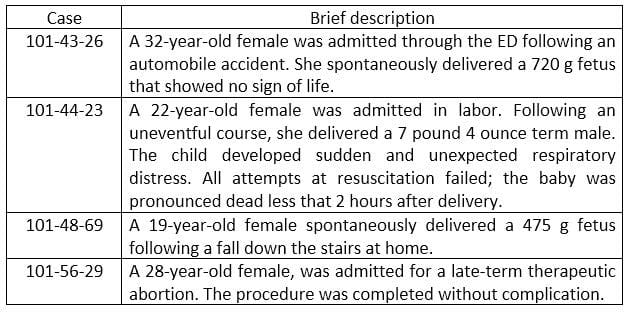Exam Details
Exam Code
:RHIAExam Name
:Registered Health Information AdministratorCertification
:AHIMA CertificationsVendor
:AHIMATotal Questions
:1826 Q&AsLast Updated
:Jul 09, 2025
AHIMA AHIMA Certifications RHIA Questions & Answers
-
Question 1661:
A major disadvantage of cross-sectional studies is that
A. the time sequence of exposure and disease is usually not known.
B. they are usually more expensive and can take a long time to complete.
C. prevalence rates cannot be calculated.
D. they cannot provide information on both exposure and disease status in the same individual.
-
Question 1662:
Which statistical analysis would be the best technique to use on the following problem?
A study compared the effects of retesting on the scores of students who failed a writing test. Students who did not pass on their first attempt were allowed to retest. Results showed that students had higher mean scores at at retest whether they attended additional tarinig before retesting or not.
A. descriptive stats
B. ANOVA
C. regression
D. T test
-
Question 1663:
The name given to the error committed when the null hypothesis is rejected and it is actually true is: The name given in
A. type II error.
B. selection bias.
C. type I error.
D. alternative hypothesis.
-
Question 1664:
The OB/GYN Department reported the following information to the Quality Management/Statistics Committee:

When the committee considers these adverse outcomes from the OB/GYN Department, which of the cases will be included in the numerator of the facility's fetal death rate?
A. 101-43-26
B. 101-43-26 and 101-44-23
C. 101-43-26 and 101-48-69
D. 101-43-26 and 101-56-29
-
Question 1665:
If population size (N) = 1200 and the proportion of subjects needed (p) = 0.5 and the acceptable amount of error (B) = 0.05, then sample size (n) =

A. 200.
B. 300.
C. 400.
D. 600.
-
Question 1666:
After the researchers see the number of subjects they will have to interview, they reexamine the criteria. The researchers could decrease the number of subjects while having the least impact the reliability of the study by

A. increasing p and decreasing B.
B. increasing p or decreasing B.
C. decreasing p and increasing B
D. decreasing p or increasing B
-
Question 1667:
John Parker surveyed members of AHIMA's student COP regarding the relationship betwed clinical experiences and job opportunities. All respondents were seniors in HIA programs ai each one expected to graduate and take the national exam within the next 6 months. Fifteen of tie eighteen respondents indicated at least one clinical rotation had resulted in a job offer. Based c this information, Parker expects to be offered a job during senior clinical rotations. John is basin this expectation on
A. scientific inquiry.
B. empiricism.
C. inductive reasoning.
D. deductive reasoning.
-
Question 1668:
Investigator A claims his results are statistically significant at the 10% level. Investigator B argues that significance should be announced only if the results are statistically significant at the 5% level. From this we can conclude
A. if investigator A has significant results at the 10% level, they will never be significant at the 5% level.
B. it will be more difficult for investigator A to reject statistical null hypotheses if he always works at the 10% level compared with investigator B who works at the 5% level.
C. if investigator A has significant results at the 10% level, they will also be significant at the5% level.
D. it will be less difficult for investigator A to reject statistical null hypotheses if he always works at the 10% level compared with investigator B who works at the 5% level.
-
Question 1669:
You point out to your administrator that the study model generally accepted to be the best method to determine the magnitude of risk in the population with the characteristic or suspected risk factor is the
A. descriptive study design.
B. analytic study design.
C. prospective study design.
D. case control study design.
-
Question 1670:
Your administrator is concerned about the snuff study (see previous question #88). The administrator would like to consider using a case control study model rather than the prospective one you are planning. One of the biggest reasons the administrator is promoting the case control model is because case control is
A. more likely to be free of design errors than a prospective study.
B. the best way to analytically test the hypothesis of cause and effect.
C. more likely to decrease recall bias errors than prospective studies.
D. less expensive than prospective studies because it uses existing records.
Tips on How to Prepare for the Exams
Nowadays, the certification exams become more and more important and required by more and more enterprises when applying for a job. But how to prepare for the exam effectively? How to prepare for the exam in a short time with less efforts? How to get a ideal result and how to find the most reliable resources? Here on Vcedump.com, you will find all the answers. Vcedump.com provide not only AHIMA exam questions, answers and explanations but also complete assistance on your exam preparation and certification application. If you are confused on your RHIA exam preparations and AHIMA certification application, do not hesitate to visit our Vcedump.com to find your solutions here.